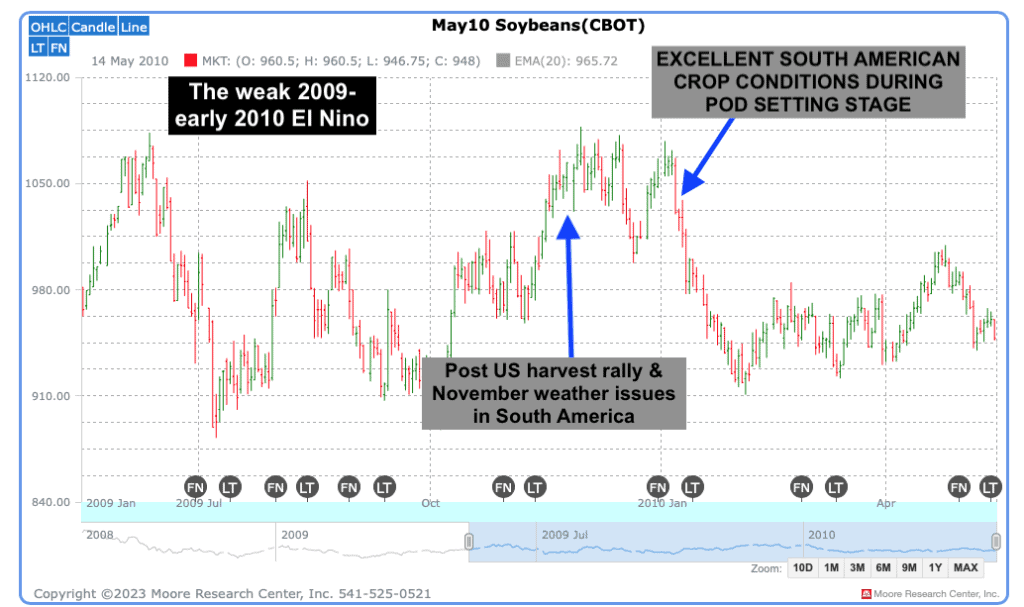Introduction:
These are the climatic factors resulting in incessant rains in southern Brazil, while northern Brazil has record heat:
- A mix between strong vs. weak El Niño conditions
- The MJO is moving into phase 2/3
- Deforestation of the Brazil rainforest
Flooding and landslides triggered by heavy rains in southern Brazil have claimed at least six lives over the past week, The fatalities occurred in the states of Santa Catarina and Rio Grande do Sul, and major property damage in the latter was reported as thousands of people sheltered in gymnasiums.
Southern Brazil has been hit by historic rains in the last few months. This could threaten soybean planting and production in two of Brazil’s key producing states.

Soybean planting in Brazil is way behind schedule (Source: AgResource)
In contrast, extreme heat is threatening soybeans in Matto Gross (the #1 soybean-producing area)


Climatological factors causing a wide variety of Brazil weather
There are a few key factors that can contribute to a pattern of flooding in southern Brazil and heat in the north during November in an El Niño year:
- El Niño shifts tropical rainfall northward, leaving southern Brazil and Rio Grande do Sul susceptible to frontal systems and atmospheric river events that stall and lead to heavy rainfall and flooding.
- The warmer tropical Atlantic waters during El Niño allow more moisture transport into southern Brazil, increasing rainfall intensity.
- With reduced tropical rainfall across northern Brazil during El Niño, prolonged heat is more common as subsidence and dry conditions dominate.
- Weakened easterly trade winds allow cold fronts to penetrate farther north into Brazil’s northern regions during El Niño.
- These displaced fronts and overall circulation changes enhance north and south Brazil’s temperature gradient and extremes.
- Deforestation of the Amazon in conjunction with El Niño, has built a huge, hot ridge in northern Brazil.


We have a mixed situation in the jetstream pattern in the Southern Hemisphere right now, while Pacific Ocean temperatures are incredibly warm, portending strong El Niño conditions, other variables we look at depict weak El Niño conditions.

The MJO
There is also a climatic phenomenon called the Madden-Julian Oscillation Index (MJO. It is like a traveling pulse of storms and rainfall that moves eastward around the equator, and it is a weather pattern that can influence things like monsoons and tropical cyclones. This makes the weather more active in some regions and quieter in others. Picture it as a cycle of increased and decreased rainfall marching across the globe.


Contrasting two El Niños: The MJO was in similar November phases during these 2 infamous El Niño events. One was weak (2009) and one strong (2015). Both of these years had heavy rains and flooding in parts of southern or central Brazil affecting either sugar cane or soybeans.
This November, it is soybean areas in Rio Grande Do Sul (#2 biggest Brazil soybean producer) and Santa Caterina experiencing the worst effects of flooding.

As my discussion illustrated at the top of this report — El Niño can often bring heavy rains to parts of central or southern Brazil. The most recent infamous case was in the fall (Brazil spring) of 2009. The result was extreme crop stress and dilution of Brazil’s sugar crop.
Brazil’s sugar crop was diluted due to heavy 2009 rains. There was also a drought in India as there was this year.


Global weather and crop conditions suggest two different types of El Niño events
During weaker El Niño events, such as in 2009 (2nd map below), notice how much further north heavy rains were during October than during the strong El Niño of 2015. This was much more of a detriment to the sugar crop than to other commodities like coffee or soybeans.


CONCLUSION:
Global weather patterns are fluctuating between weak and strong El Niño conditions. Despite its weakness, historically weak El Niño events, like 2009-2010, impacted global crops such as sugar and cocoa, leading to notable market volatility.
This season, intensified weather extremes in Brazil, fueled by a strengthened northern Brazil ridge, raise concerns for soybean production in Matto Grosso. The heightened ridge, stronger than in November 2009, may amplify crop problems, underscoring the potential extreme volatility in the soybean market.
Will the 2009-2010 pattern be similar this season for the soybean market? This is what I will be answering for subscribers to my WeatherWealth newsletter.

Frequent trading strategies and long-range weather forecasts are available for multiple commodities.



